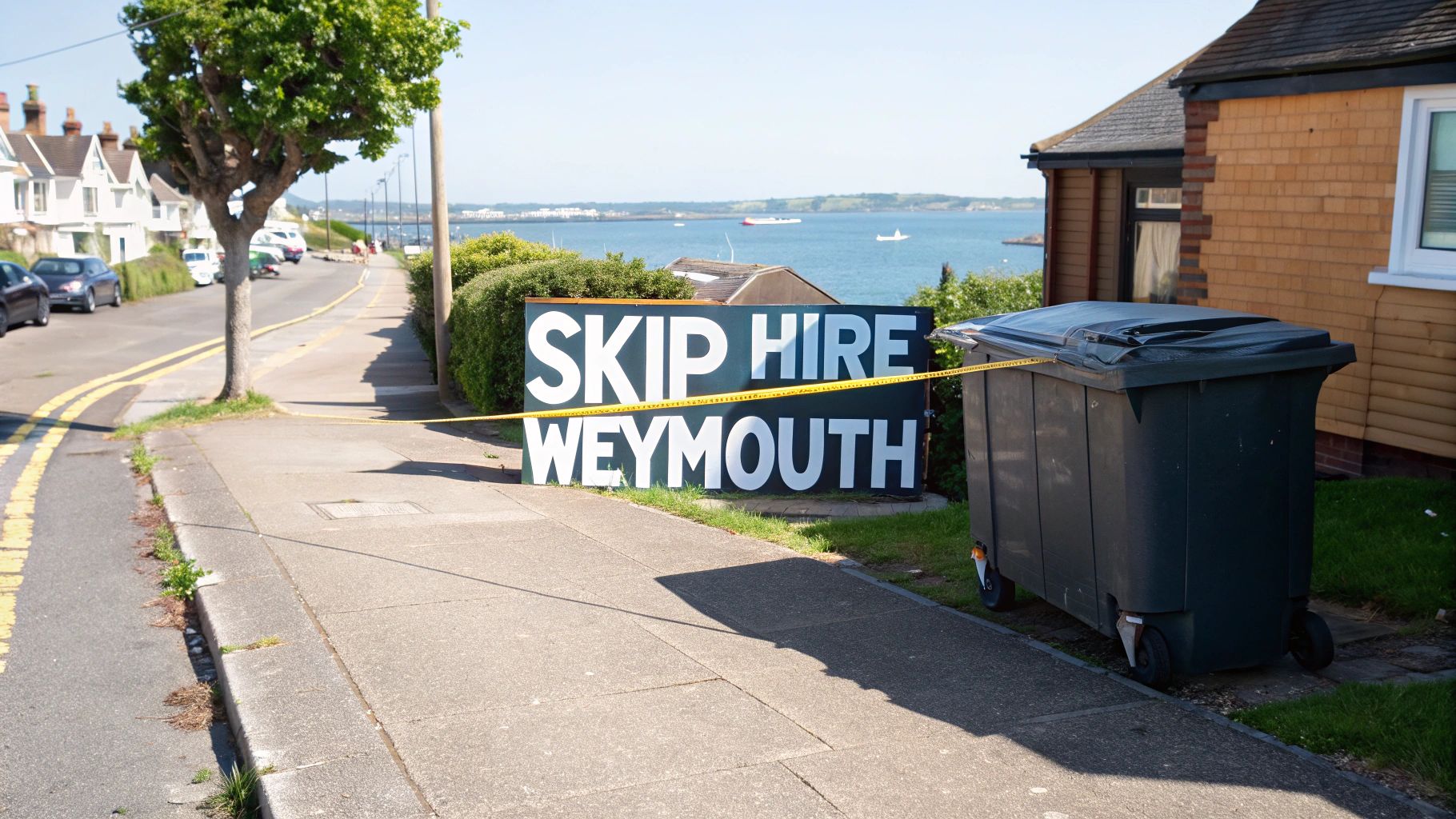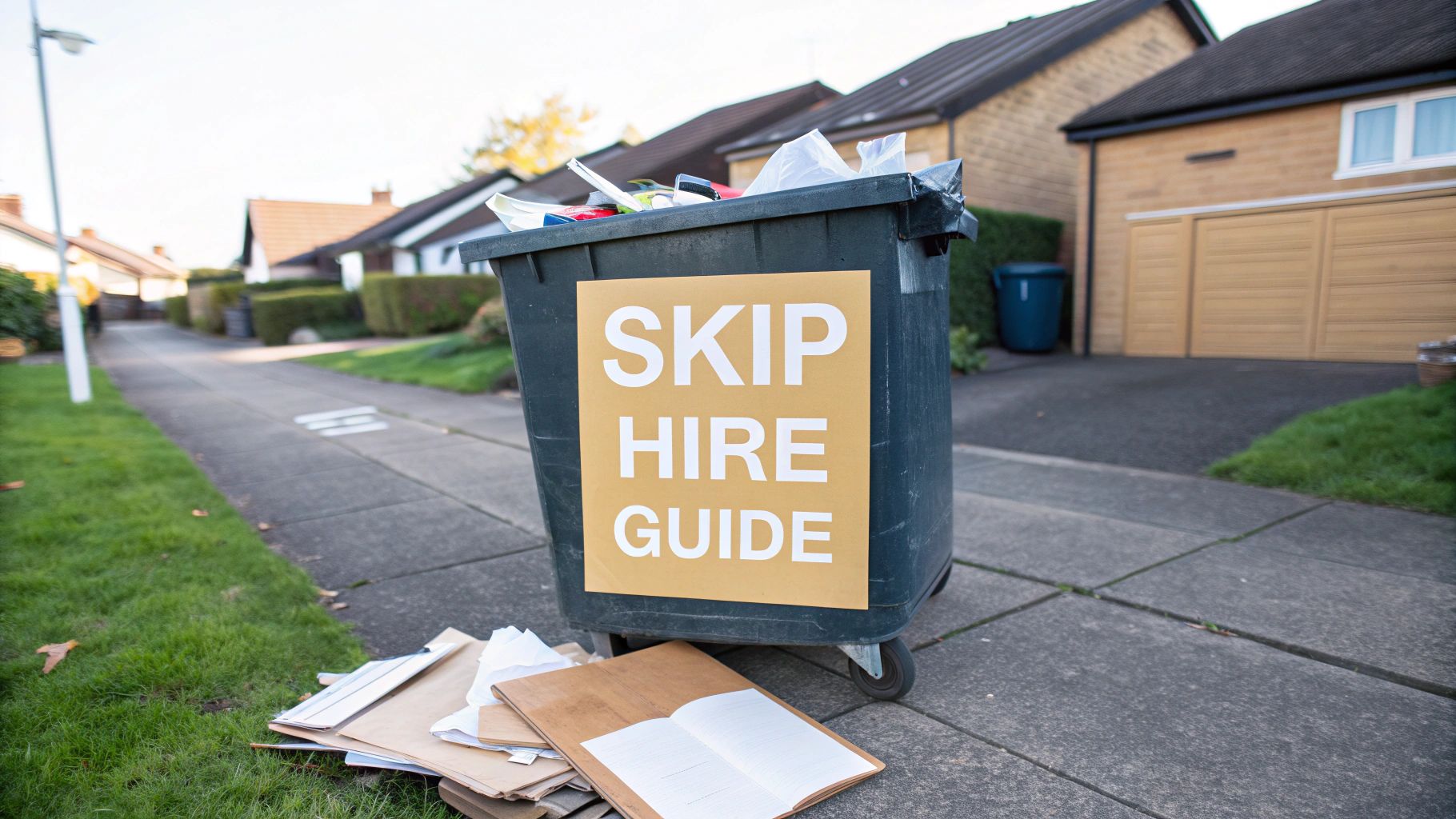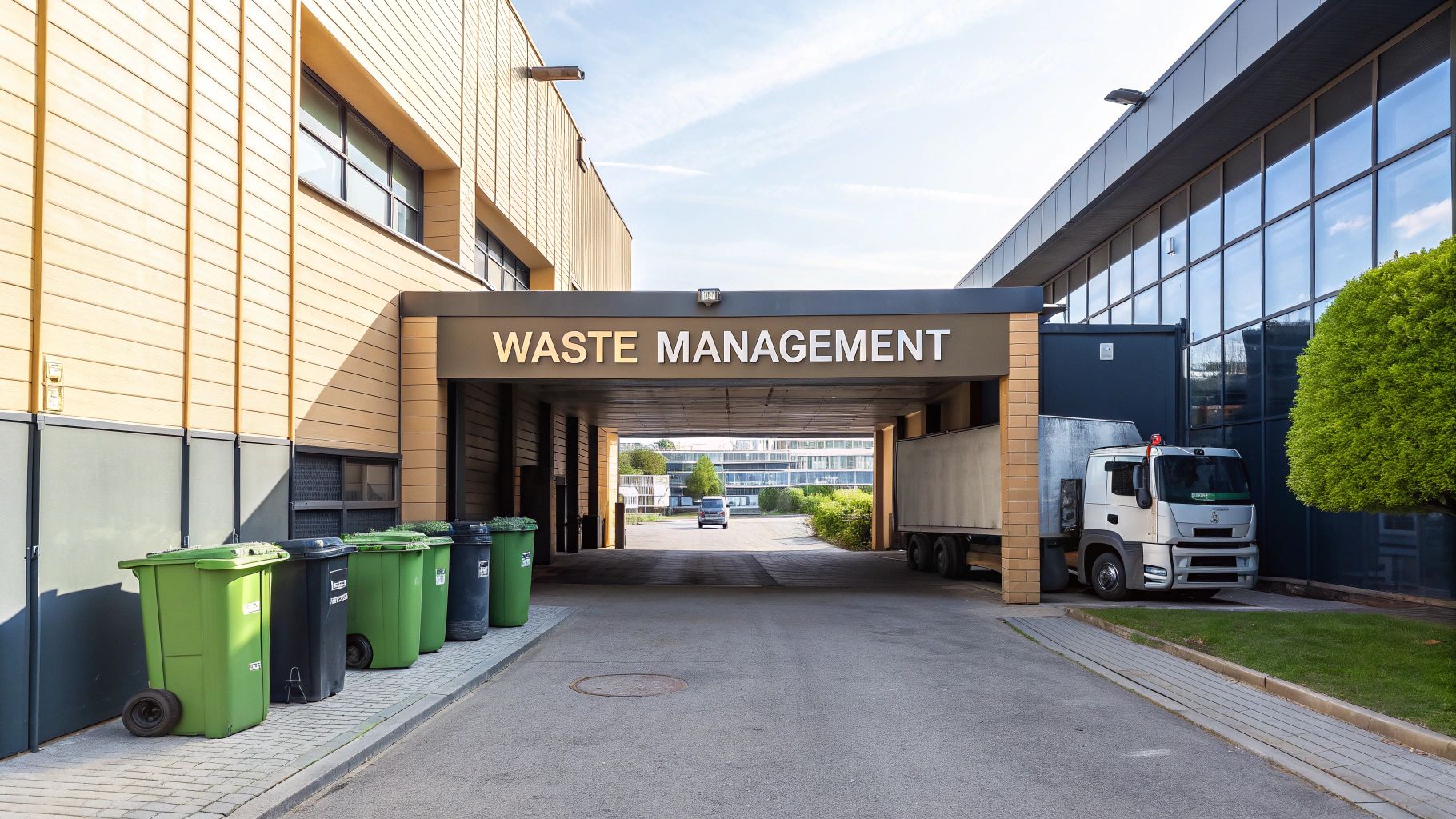What Is a Waste Transfer Note UK Guide
What Is a Waste Transfer Note UK Guide
A Waste Transfer Note, or WTN, is a crucial legal document. Think of it as an official receipt that proves your UK business has handed its non-hazardous waste over to a licensed carrier, doing everything by the book. It creates a paper trail, showing you've met your legal ‘Duty of Care’. This simple record is your first line of defence against some pretty hefty fines for improper waste disposal.
Understanding Your Legal Duty of Care
Every single business in the UK that creates, handles, or gets rid of commercial waste has a legal responsibility known as the Duty of Care.
Picture it as a chain of responsibility. You are legally on the hook for your waste from the moment it's created until it's properly recycled or disposed of at a licensed facility.
This duty isn't just a friendly suggestion—it's the law, put in place to stop waste from harming people or the environment. The Waste Transfer Note is the key piece of paper (or digital file) that proves you've done your part. Without it, if your waste ends up illegally dumped or fly-tipped, your business could face serious trouble, even if you paid someone else to take it away.
Who Needs a Waste Transfer Note?
The rules here are straightforward: if your business produces any kind of commercial waste, you need a WTN for every single collection. This applies to everyone, from a small high street shop with cardboard packaging to a massive construction site dealing with mixed debris. This documentation covers all 'controlled waste', which is the official term for most types of commercial and industrial waste.
A WTN is the cornerstone of your compliance. It is the official record confirming you handed your waste to an authorised person, detailing exactly what the waste is, how it's contained, and where it's going.
The Bigger Picture of Waste Tracking
The UK generates a staggering amount of waste—over 200 million tonnes every year—which makes tracking it absolutely essential for protecting our environment. For a long time, the paper WTN was the only tool for the job.
The problem is, the current mix of paper and digital records makes it tough to get a clear, nationwide picture of where all this waste is going. This confusion contributes to problems like fly-tipping, which costs the UK economy an estimated £1 billion per year.
This legal framework is designed to make sure every piece of commercial rubbish is accounted for. Different kinds of waste also need their own specific paperwork. For example, while a WTN is fine for your general rubbish, you need to follow the separate and much stricter hazardous waste disposal regulations for materials like asbestos or chemicals.
In a similar vein, other important documents like a Certificate of Destruction provide legally recognised proof for the secure disposal of sensitive items. The whole system is built to ensure everyone is accountable and acts as a responsible environmental steward.
How to Complete a Waste Transfer Note Correctly
Filling out a Waste Transfer Note (WTN) is more than just a box-ticking exercise; it's about creating a legally solid document that shields your business. Every single field has a purpose, and together they build a clear, compliant audit trail. Getting these details spot on is a massive part of fulfilling your Duty of Care.
The infographic below shows just how central the Waste Transfer Note is to the whole process, acting as the handshake between you (the waste producer) and the licensed waste carrier who takes it away.

Think of the WTN as the official handover document. It's your proof that you’ve passed the waste into the legitimate, regulated management chain.
Breaking Down the Key Sections
Right, let's get into the nitty-gritty. While there isn't one single, mandatory template everyone has to use, all compliant WTNs must contain the same core information. We'll walk through the essentials you absolutely have to get right.
The table below breaks down each piece of mandatory information you need for a valid Waste Transfer Note. It explains what each field means, why it’s so important, and gives you a practical example of how to fill it in correctly. Getting this right is the key to staying compliant.
Mandatory Information for a Valid Waste Transfer Note
| Field/Section | What It Is | Why It's Important | Example/How to Complete |
|---|---|---|---|
| Waste Description | A specific, detailed summary of the waste being transferred. | Vague terms can invalidate the note. It ensures the carrier knows what they're handling and can dispose of it correctly. | Good: "Mixed construction debris including broken bricks, concrete rubble, and offcuts of untreated timber." Bad: "Builder's waste." |
| Quantity & Containment | A reasonable estimate of the waste's volume or weight, and how it's packaged. | Helps the carrier plan logistics and ensures skips or containers aren't overloaded. It also aids in accurate record-keeping. | "Approx. 4 tonnes, loose in one 8-yard skip" or "Ten large rubble sacks, total weight approx. 250kg." |
| EWC Code(s) | The six-digit European Waste Catalogue (EWC) code that classifies the waste type. | This is a legal requirement for standardised classification across the industry, ensuring the waste goes to the correct facility. | For mixed construction and demolition waste, you'd likely use code 17 09 04. For general office waste, 20 03 01 is common. |
| Your Details (Transferor) | Your full company name, the collection address, and your business's SIC code. | Clearly identifies you as the producer of the waste, linking the Duty of Care back to your business. | "ABC Construction Ltd, Site C, Industrial Estate, Anytown, AB1 2CD. SIC Code: 41202." |
| Carrier Details (Transferee) | The full name, address, and Waste Carrier Registration Number of the company collecting the waste. | This is your proof that you handed the waste to a legally authorised carrier. Never skip verifying this number. | "The Waste Group, Unit 5, Business Park, Anytown, XY3 4ZA. Waste Carrier Reg No: CBDU123456." |
| Date & Signatures | The date and time of the transfer, plus signatures from both your representative and the carrier's driver. | This formalises the handover and acts as a time-stamped, legally binding confirmation that the details are accurate. | Both parties sign and date the document at the point of collection. Keep your copy safe for at least two years. |
Completing each section with care isn't just about following rules; it's about creating a robust, defensible record. This document is your first line of defence if regulators ever come knocking, proving your business takes its environmental responsibilities seriously. For larger jobs, having this process locked down within a bigger framework is essential, which you can learn more about in our guide to creating a construction waste management plan.
Choosing Between Single Notes and Season Tickets

When it comes to your waste transfer notes, you’ve got two main choices. Picking the right one isn't just about ticking a box; it can genuinely save you a mountain of paperwork while making sure you're always on the right side of the law. Your options are the single waste transfer note and the waste transfer season ticket.
A single WTN is your go-to for one-off waste collections. Think of it as a simple receipt for a specific, individual transfer. It's the perfect tool when your waste collections are irregular or unpredictable.
Maybe you're having a major office clear-out, finishing up a shop refurbishment, or dealing with waste that changes in type and volume each time. For these situations, a single WTN is the only legally compliant choice. Every single collection needs its own fresh note.
When to Use a Season Ticket
On the flip side, if your business produces the exact same type of waste on a regular, predictable schedule, the "season ticket" is a game-changer. This is a single document that can cover multiple, identical collections for up to 12 months.
Picture a restaurant that has its food waste collected every single Tuesday by the same company. Instead of filling out a new WTN for all 52 collections over the year, they can issue one season ticket to cover every single transfer.
A season ticket acts like an annual pass for your waste. It’s valid for a year, but only if the journey—from your business to the disposal site—and the passenger (the waste itself) remain exactly the same for every single trip.
This drastically cuts down on admin and makes your record-keeping much simpler. But be warned: this convenience comes with very strict rules you absolutely cannot bend.
The Strict Rules for Season Ticket Validity
For a season ticket to be legally valid, every single collection it covers must be identical across four key areas. If just one of these details changes, even once, the season ticket is void for that particular transfer, and you must issue a single WTN instead.
These are the non-negotiables:
- The Waste Producer: The business creating the waste (that's you) must always be the same.
- The Waste Carrier: The company collecting and transporting the waste has to be the same one every time.
- The Waste Type: The waste description and its EWC code can't change. A season ticket for "mixed food waste" (EWC code 20 01 08) can’t be used if one week you suddenly add cardboard packaging to the collection.
- The Disposal Site: The waste must be transported to the same authorised facility after every collection.
Getting this right is a crucial part of setting up efficient and compliant commercial waste collection services. For instance, a construction firm working on different sites and producing varied materials like soil, rubble, and timber would have to use single WTNs. Their waste stream is far too inconsistent for a season ticket.
Remember, a season ticket is only valid for a maximum of one year and has to be renewed on time. Even with one in place, you still need to keep a simple log of each individual collection, which is usually done through weighbridge tickets or a basic transfer schedule.
Issuing and Storing Your WTNs for Compliance

Creating a perfect Waste Transfer Note is a big step towards staying on the right side of the law, but it's really only half the job. To truly protect your business and create a solid audit trail, you need to get the issuing, signing, and storage right.
Think of it like this: the completed WTN is a signed contract. What you do with it afterwards is just as important as the details you wrote down in the first place.
While it’s often the waste carrier or skip hire company that fills out the form, the legal responsibility for its accuracy lands squarely on your shoulders as the waste producer. It’s a joint effort – both parties need to give it a final check to make sure every detail is spot on before it’s official.
Who Signs the WTN and When
A Waste Transfer Note isn’t worth the paper it’s printed on until it's been signed by both you and the waste carrier. This simple act formalises the handover, creating a legally binding record that confirms the information on the note is a true reflection of the waste being collected.
The signatures need to come from someone representing your business (that’s the ‘transferor’) and the driver from the waste company (the ‘transferee’). This isn’t something to do later; it has to happen right at the moment of collection. This creates a time-stamped record of exactly when the waste left your hands.
If the Environment Agency or your local council asks to see your WTNs and you can't produce a signed copy, you're in direct breach of your Duty of Care. It’s the business equivalent of driving without a licence – the signed document is your proof that you’re operating legally.
Without both signatures, the note is incomplete. An auditor could simply dismiss it, leaving your business wide open to potential fines.
Your Legal Record-Keeping Requirements
Once that note is signed, your copy becomes a crucial business record. And the law is very clear about how long you need to hang onto it.
For any non-hazardous waste you transfer, the rules are straightforward:
- Minimum Storage Period: You must keep all WTNs for at least two years from the date of the waste transfer.
- Hazardous Waste Exception: If you're dealing with hazardous waste (which uses a Hazardous Waste Consignment Note), the storage period is longer – a minimum of three years.
The UK’s Waste Transfer Note system has been the backbone of tracking controlled waste since the early 90s, demanding a clear paper trail for every single movement. But here's a worrying statistic: research shows that up to 41% of paper-based WTNs are missing key information. It just goes to show how easily things can go wrong without a good system in place. You can learn more about the history of this legislation and the challenges of paper-based compliance.
Paper vs Digital Storage: Which is Better?
So, where do you keep all these notes? You’ve got two main choices: the old-school paper filing cabinet or a modern digital system. The best option for you really depends on the size and scope of your business.
Paper Filing:
- Pros: It’s simple, familiar, and doesn't require any fancy tech.
- Cons: Paper is vulnerable. It can be lost, damaged by fire or water, or just misfiled into oblivion. Trying to dig out a specific note from 18 months ago can feel like searching for a needle in a haystack.
Digital Storage:
- Pros: It’s secure, instantly searchable, and saves a ton of physical space. Plus, you can back it all up. Need a note for an audit? You can find it in seconds.
- Cons: You need a reliable process for scanning your notes and a secure system to protect them from digital threats.
For most businesses these days, going digital is the clear winner. A simple approach is to scan your signed paper copies and save them in clearly labelled folders, organised by date. It's a small change that ensures you can pull up any WTN an auditor asks for instantly, proving you’re on top of your responsibilities.
Preparing for Mandatory Digital Waste Tracking
The days of paper-based waste transfer notes are numbered. The UK government is bringing in a mandatory digital waste tracking system, and it’s going to completely change how businesses handle their Duty of Care.

This isn’t just about swapping paper for pixels. It’s a major strategic move to create a transparent, real-time picture of where the country's waste actually goes.
The goal here is simple: to clamp down on waste crime. Fly-tipping and illegal exports have been able to flourish because paper records are so often fragmented and incomplete. By creating a single, unified digital platform, regulators will have a much more powerful tool to monitor waste and spot suspicious activity as it’s happening. For businesses, this ultimately means a much more straightforward way to prove you’re doing the right thing.
The End of Paper as We Know It
This new system will change the day-to-day reality of waste management. In practice, the traditional Waste Transfer Note and the hazardous waste consignment note will be folded into a single, integrated digital record. Every time waste is produced, collected, or handled, the details will have to be logged on the central system right away.
This real-time data entry is the heart of the new approach. It’s designed to get rid of the errors, gaps, and lost paperwork that are far too common with the old paper forms. It does mean that businesses and waste carriers will need to get comfortable with new digital tools, leaving the clipboards and filing cabinets behind. As the industry moves this way, understanding how technology like QR codes for logistics works can give you a good idea of the kinds of systems that will become standard.
The new digital system is designed to provide "one version of the truth" for every tonne of waste. By creating a live, unchangeable record from producer to final disposal, it aims to make it significantly harder for waste to 'disappear' from the legitimate system.
A Unified Platform for All Waste Types
The familiar Waste Transfer Note is set to be fully replaced by a digital system, with the launch now scheduled for April 2026. This digital leap is being driven by the fact that huge parts of the industry still rely on paper records, which has led to a shocking 41% missing information rate on paper WTNs.
The new system will replace not just the WTN but also hazardous waste consignment notes and Annex VII forms for green list exports. It’s all about bringing previously separate reporting streams together onto one single platform.
How Your Business Can Prepare Now
Waiting until the last minute to get ready is a risky game. You can start preparing for this digital shift right now to make sure it’s a smooth, stress-free transition when the time comes. Getting ahead of the curve won't just prevent a last-minute panic; it'll improve your waste management processes today.
Here are a few practical steps you can take:
- Review Your Current Processes: Take a proper look at how you manage your WTNs at the moment. Who’s responsible? Where are the records kept? How do you check your waste carrier’s details? Knowing your current workflow inside-out is the first step to making it better.
- Start Digitising Your Records: Even if you're still using paper notes, get into the habit of scanning and storing them digitally. Set up a clear, organised filing system on a secure server. This simple act will make you more organised and get your team ready for a fully digital future.
- Talk to Your Waste Carrier: Have a chat with your waste management partner about their plans for the digital switch. A good, forward-thinking carrier will already be getting their systems in order and can give you advice on how to align with their new processes.
- Train Your Staff: Make sure everyone in your business who deals with waste paperwork understands that a big change is on the horizon. A bit of training on the importance of accurate data and the legal weight of these digital records will go a long way.
This transition is a huge step forward for the UK waste industry. It promises greater accountability and a real shot at cutting down on environmental crime. By getting your house in order now, you can ensure your business stays compliant, efficient, and ready for the future of waste management.
Answers to Your Waste Transfer Note Questions
Even when you've got the basics down, a few practical questions always pop up when you're dealing with Waste Transfer Notes day-to-day. We get it. Here are some straight answers to the most common queries we hear, designed to clear things up and help you manage your waste with confidence.
What Happens If I Lose a Waste Transfer Note?
Losing a WTN is a bigger deal than you might think, as it leaves a gap in the paper trail you're legally required to keep. If the Environment Agency knocks on your door for an audit and you can't show them a specific note from the last two years, you’re officially in breach of your Duty of Care.
First thing’s first: call your waste carrier straight away. They have the same legal duty to keep a copy for the same amount of time. Ask them to send over a digital or physical copy for your records.
If for some reason they can't provide one, make sure you document your attempts to get it back. This shows you've made a real effort, which might help your case, but it doesn't plug the legal gap. The only real defence is a solid storage system—ideally digital—to stop them from going missing in the first place.
Do I Need a WTN for Every Single Bin Collection?
Great question, and it all boils down to how predictable your waste is. If your general waste bin gets picked up like clockwork (say, every Tuesday), is always full of the same kind of stuff, and the same licensed carrier collects it, then you can use a season ticket.
A season ticket is a single WTN that covers all of these identical, repeating collections for up to 12 months. It’s a massive time-saver.
But, if you have a one-off collection—like clearing out an old storeroom full of junk—that needs its own, single WTN. Why? Because it’s not part of your regular, repetitive waste.
Think of it like this: a season ticket is for the routine, everyday waste your business churns out. Anything that breaks that routine needs its own note.
Is an Email Confirmation the Same as a WTN?
Absolutely not. An email confirmation or a simple invoice is not a valid substitute for a proper Waste Transfer Note. While those documents are handy for your accounts department, they don’t contain the specific, legally required details for waste compliance.
A proper WTN has to include:
- A detailed description of the waste.
- The correct European Waste Catalogue (EWC) codes.
- Your business's SIC code.
- The waste carrier's registration number.
- Signatures from both you (the producer) and the carrier.
An invoice or booking confirmation will be missing most, if not all, of these crucial details. You should always insist on getting a fully completed WTN for every transfer or make sure you have a valid season ticket in place.
Who Is Actually Responsible for Filling Out the Note?
This is a common point of confusion. While your waste carrier or skip hire company will often provide the form and fill it out for you, the legal responsibility for its accuracy is shared. As the person producing the waste, you are legally on the hook for making sure every detail is correct before you put your name to it.
Never, ever sign a blank or half-finished form. It's your job to double-check that the waste description is right, the EWC codes match what you're throwing out, and the carrier's details are present and correct. Signing an incorrect WTN means you’re taking the blame for that mistake, which could land you with a fine down the line. Your signature is your promise that you've checked everything.
What Is the Difference Between a WTN and a Consignment Note?
Getting this right is crucial, as it all depends on what kind of waste you’re getting rid of. They are both legal tracking documents, but they’re used for completely different categories of waste.
- Waste Transfer Note (WTN): This is for your everyday non-hazardous waste. Think cardboard, office paper, food scraps, and general mixed rubbish from a construction site.
- Hazardous Waste Consignment Note: This is the one you need for hazardous waste. This includes anything that could harm people or the environment, like asbestos, chemicals, oily rags, batteries, fluorescent light tubes, and old electricals (WEEE).
The paperwork for a consignment note is much stricter, with a more detailed tracking system involving copies for you, the carrier, and the final disposal site. Using the wrong one is a serious compliance breach. If you're ever unsure if your waste is hazardous, it’s your duty to find out before it gets collected.
At The Waste Group, we make compliance straightforward. Whether you need a small skip for a garden clearance or a comprehensive waste management plan for a large commercial site, our team ensures you have all the correct documentation, every single time. Simplify your waste management by visiting https://www.thewastegroup.co.uk to book your service online today.



